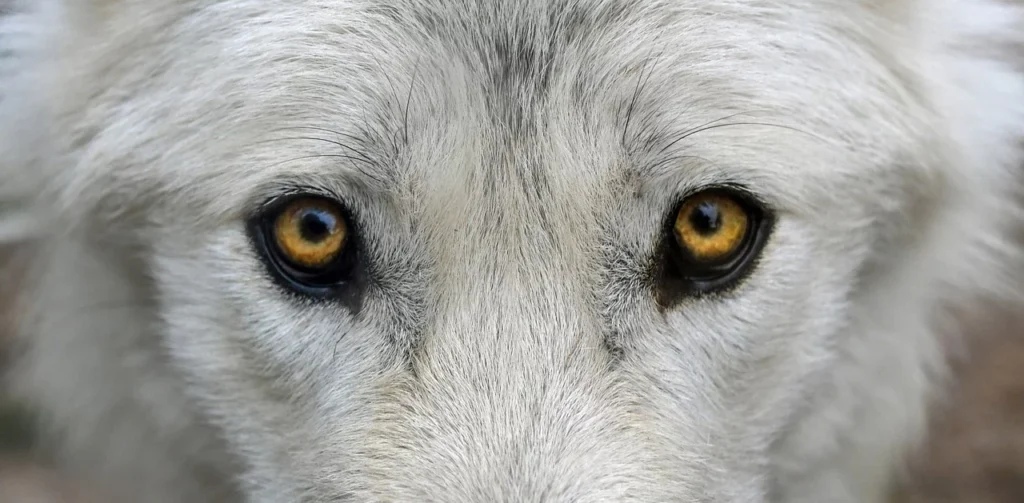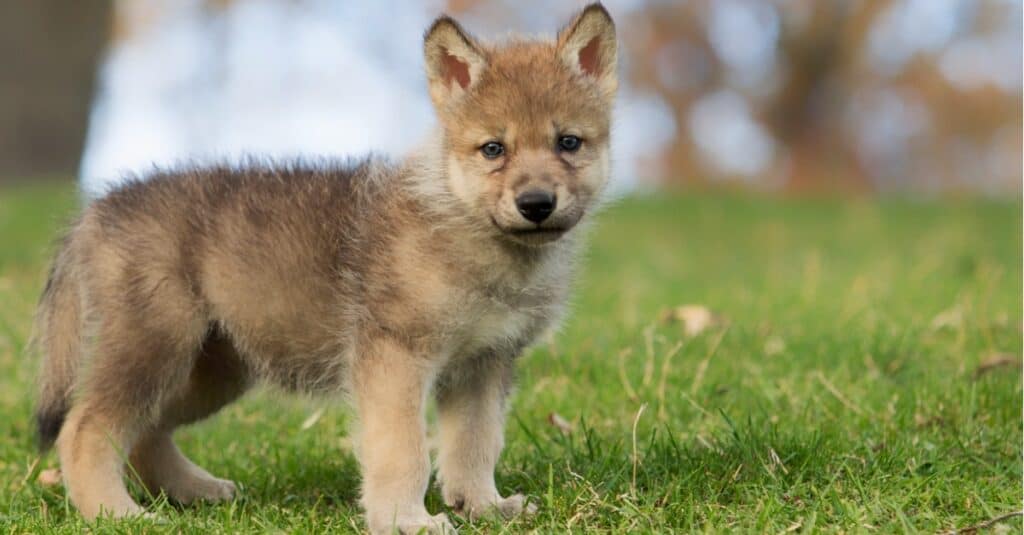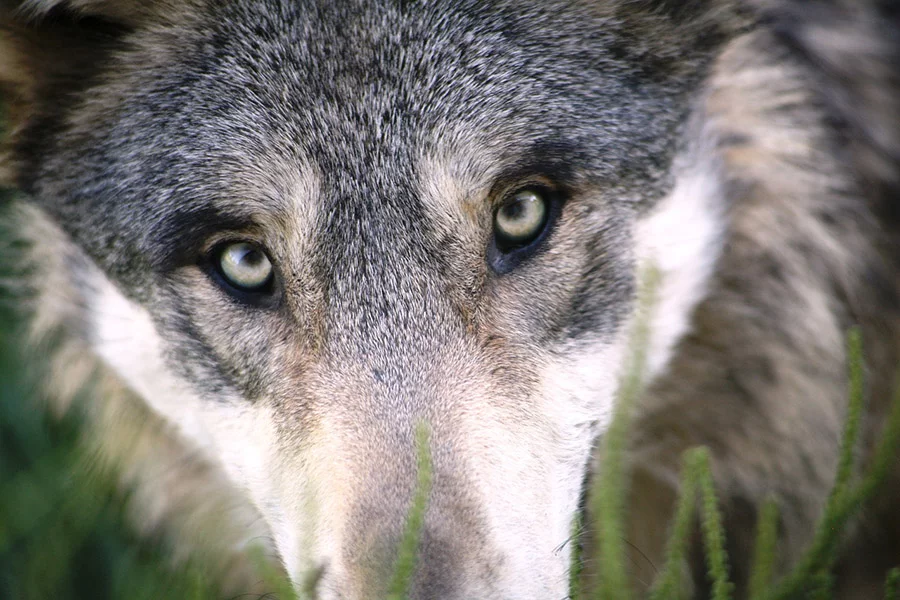Have you ever wondered what colors can wolves’ eyes be? Well, get ready to dive into the fascinating world of wolf eye colors with us! From the predominant yellow or amber eyes to debunking myths about red and purple eyes, we’ll explore it all. We’ll even take a closer look at the evolution of eye colors in wolf pups and the mesmerizing glow in a wolf’s eyes. Plus, we’ll compare wolf eyes to dog eyes and uncover the secrets behind their shape and function. So, if you’re ready to embark on this eye-opening journey, let’s get started and uncover the captivating spectrum of wolf eye colors together!
A Closer Look at Wolf Eye Colors
Consider the quintessential image of a wolf: a magnificent beast, its lush coat contrasting against the wilderness, and its eyes – bewitching, warm golden yellow or amber, reflecting the ambient light with an intensity that’s almost otherworldly. Indeed, this captivating color is not just an aesthetic feature, but a signature trait of these fascinating creatures. However, it’s crucial to remember that not all wolves are born with this iconic amber gaze. The spectrum of wolf eye colors is broad and can span from the usual yellow to rare shades like blue or green, primarily due to genetic diversity and differences between subspecies.
| Eye Color | Commonality | Genetic Factors |
|---|---|---|
| Yellow or Amber | Most Common | Presence of Pheomelanin |
| Blue or Green | Less Common | Genetic Diversity and Subspecies Differences |
The yellow or amber eye color in wolves is attributed to the presence of a pigment called pheomelanin. Also responsible for red and yellow coloration in animals, this pigment, in combination with the unique structure of the wolf’s eye, reflects light to produce the mesmerizing amber color we’re familiar with. This coloration doesn’t merely add to their striking appearance but also plays a pivotal role in their survival and adaptation to various environments.
So, while the alluring image of a wolf with glowing yellow eyes is indeed the most common sight, it’s essential to appreciate the diversity of wolf eye colors. Whether meeting the intense gaze of a wolf with the usual amber eyes or being surprised by a wolf with rare blue or green eyes, the experience is always a testament to the incredible genetic diversity of this majestic creature.
The Predominant Yellow or Amber Eyes

wolf eyes
When you picture a wolf in your mind’s eye, you likely envision a creature of striking beauty, with a thick coat of fur and eyes that gleam with an intense yellow or amber light. This characteristic coloration is not a mere aesthetic feature; it is a significant aspect of the wolf’s survival strategy, playing a pivotal role in its ability to adapt and thrive in a variety of environments.
The yellow or amber hue that is so often seen in a wolf’s eyes can be attributed to the presence of a pigment known as pheomelanin. This pigment, which is also responsible for the red and yellow coloration observed in many other animals, interacts with the unique structure of the wolf’s eye, reflecting light in such a manner that we perceive it as yellow or amber.
But why would evolution favor such a color? The answer lies in the hunting habits of this remarkable predator. Wolves are adept hunters, with their eyes being specially tuned to detect contrast and movement. The yellow or amber eye color aids in distinguishing colors, a crucial advantage during hunting. This ability to discern subtle differences in color and movement enables wolves to track their prey with exceptional accuracy, making the difference between a successful hunt and an empty stomach.
The Rarity of Blue and Green Eyes
While yellow or amber eyes are the norm among wolves, there are exceptions to this rule. Occasionally, one may encounter a wolf with blue or green eyes – a sight that is as fascinating as it is rare.
Blue eyes are typically found in wolf pups, and it’s a breathtaking sight to behold. As these pups mature, however, the blue often fades, replaced by the more conventional yellow or amber. Adult wolves with blue eyes are quite uncommon, and when they do occur, it’s usually due to a lack of pigmentation in the eye. This lack of pigment allows light to enter and exit the eye in a particular way, resulting in the scattering of light known as the Tyndall effect, which creates the blue hue.
Read all about: How Big Are Wolves? A Fascinating Size Comparison with Dogs, Humans, and Other Wild Animals
Green eyes, on the other hand, are even more of an anomaly. The green coloration is thought to occur due to a combination of yellow pigmentation and the blue scattering of light, resulting in what we perceive as green. Truly green eyes are extremely rare in wolves, and sometimes, the yellow or amber eyes of a wolf may give off a greenish hue under certain lighting conditions or environmental reflections. Regardless of the rarity, the sight of a wolf with green eyes is nothing short of mesmerizing.
In the end, whether their eyes are yellow, blue, or green, these majestic creatures continue to captivate us with their beauty and mystique. The diversity of wolf eye colors serves as a testament to the incredible genetic diversity of the species, adding another layer of intrigue to these remarkable animals.
Debunking Myths: Red and Purple Eyes
As we continue our journey into the captivating world of wolf eye colors, it’s time to address some prevalent myths. The tales of wolves with red or purple eyes have been circulating in folklore and fantasy, capturing imaginations with their mystical allure. However, these colors are far from the norm in the wild wolf populations, and their existence primarily dwells within the realm of fiction.
Let’s start with the myth of the red-eyed wolf. Red eyes in wolves, contrary to popular belief, are extremely rare and seldom observed in their natural habitat. This perception often arises from a fascinating natural phenomenon known as “eyeshine.” In low light conditions, the wolf’s eyes may appear to glow red due to light reflecting off a structure called the tapetum lucidum located behind the retina. This reflection enhances their night vision, allowing them to adeptly move and hunt in the dark.
“True red eyes in animals are usually due to albinism, which is extremely uncommon in wolves.”
Albinism, a condition characterized by a lack of pigmentation, can cause red eyes in some animals. But even in the rare instances of albinism in wolves, their eyes are often more of a pink or light blue hue, not red. So, the perception of red eyes in wolves is more a matter of lighting and reflection, not a true representation of their iris color.
Read all about: Are Lions Dangerous? Discover the Truth About Lion Attacks on Humans
Now, onto the concept of wolves with purple eyes – a color that, although frequented in fantasy literature, lacks biological credibility. There are no documented cases of wolves with naturally purple eyes. Perception of purple eyes in wolves is likely due to unusual lighting conditions or reflections.
So what governs the eye colors in wolves? The answer lies in their genetics and pigmentation. These factors do not allow for naturally purple eyes, making the purple-eyed wolf a resident of myth and fiction rather than factual reality. By understanding the true nature of wolf eye colors, we can better appreciate the authentic beauty of these majestic creatures and avoid being led astray by fanciful myths.
The Fascinating Journey of Eye Color in Wolf Pups

wolf pup
Imagine, if you will, a tender, newborn wolf pup nestled in the heart of its den. Its eyes are closed, as they are in the first stages of life, concealing a captivating secret – a stunning blue gaze. After approximately 12 to 15 days of life, this secret is unveiled. The wolf pups’ eyes flutter open, revealing a pair of strikingly blue irises that could rival the depth of the clearest ocean.
However, like the ephemeral beauty of a sunset, this deep blue hue is but a fleeting phase of the wolf pup’s development. Over the ensuing weeks and months, mother nature weaves her magic, and a fascinating transformation begins to take place in the eyes of the wolf pup.
The once vibrant blue color starts to fade, gradually giving way to a golden yellow or amber hue. This shift is not a mere coincidence or random occurrence. Rather, it’s a result of the developing pigmentation within the pup’s eyes as it matures and grows, a testament to the intricate and complex processes of nature.
By the time a wolf pup reaches the age of three to four months, the journey of its eye color evolution is usually complete. The pup’s eyes will have morphed into their permanent color, typically a warm amber or a golden yellow. This color is not only the most common amongst adult wolves, but it also serves as a distinctive identifier, a unique badge of honor in the wild.
It’s worth noting that this color change is not solely for aesthetic purposes. Rather, it’s a compelling example of how nature equips its creatures for survival, with the darker eye color in adult wolves aiding in the absorption of light in dim conditions, enhancing their hunting abilities.
So, the next time you gaze into the eyes of a wolf, remember this captivating journey. From the initial mesmerizing blue of a pup’s eyes to the commanding amber of an adult’s gaze, the evolution of eye color in wolves is indeed a fascinating chapter in the book of nature.
The Mysterious Luminosity in a Wolf’s Eyes
Imagine being in the wilderness on a moonlit night. A pair of eyes suddenly glow in the distance, piercing the darkness with an unworldly gleam. These are the eyes of a wolf. That eerie glow is not a result of magic or myth, but a biological marvel that enhances their survival prowess.
At the heart of this luminescence is an intricate structure nestled in a wolf’s eyes called the tapetum lucidum. This layer of cells is like a secret mirror hidden behind the retina, reflecting light back into the eye, thereby maximizing the wolf’s ability to see in the dark. This phenomenon, known as eyeshine, intensifies the wolf’s night vision, turning them into masters of nocturnal hunting.
The eyeshine is not a color indicator of the wolf’s eyes. Contrarily, it can manifest in an array of hues such as green, yellow, red, or even blue. The color spectrum of this glow is influenced by several factors. The minerals present in the tapetum lucidum, the angle at which the light enters the eye, and the color of the light source all contribute to the vibrant display of the eyeshine.
Wolves, with their intense eyeshine, are often perceived as creatures of the night, their eyes glowing like lanterns in the dark. This intriguing feature is not unique to wolves but is common among many nocturnal animals. Yet, the eyeshine in wolves is particularly intense, contributing to their mythical reputation.
So the next time you see a pair of glowing eyes in the wild, remember the fascinating biology behind it. The tapetum lucidum and its role in producing that mesmerizing glow is a testament to the wolf’s adaptability and survival in the wild, making them one of nature’s most enduring and awe-inspiring creatures.
Comparing Wolf Eyes to Dog Eyes: A Study in Contrast and Similarity
At the intersection of nature and nurture lies an intriguing spectrum of ocular diversity. The eyes of wolves and dogs, while similar in structure, offer a fascinating case study on the influence of genetics, environment, and selective breeding on eye color.
Wolves, the majestic forebears of domestic dogs, typically sport eyes of golden yellow or amber hues, a characteristic trait that has served them well in their wild habitats. This eye color, a result of evolution and adaptation, enhances their hunting prowess by facilitating better light absorption in low-light conditions. However, when we turn our gaze to the myriad breeds of dogs that grace our homes today, we encounter a veritable rainbow of eye colors.
Read all about: “Are Dolphins Truly Friendly? Exploring Their Fascinating Relationship with Humans”
Dogs, descendants of wolves, can exhibit a wide range of eye colors – from the common brown to the unique green, the ethereal blue, and even the unusual phenomenon of heterochromia, where each eye is a different color. The Siberian Husky, for instance, is often celebrated for its striking blue eyes, a feature less common in its ancestral counterparts.
“The diverse eye colors in dogs are primarily a result of selective breeding and domestication.”
Despite these variations, one commonality between the eyes of wolves and dogs is the presence of the tapetum lucidum – a layer of cells that reflects light back into the eye, enhancing their vision in low light conditions. This feature gives both wolves and dogs superior night vision, a characteristic crucial to their respective survival strategies. The eyeshine caused by the tapetum lucidum can vary in intensity and color between wolves, dogs, and even among different dog breeds, adding another layer of complexity to their optical adaptations.
Thus, while the eyes of wolves and dogs share a common structure and function, years of evolution and domestication have led to some distinct differences, eye color being one of them. This interplay of genetics, adaptation, and human intervention has resulted in a captivating array of eye colors that continue to intrigue scientists and dog lovers alike.
Eye Shape and Function: The Artistry and Utility of Wolf Eyes
Peering into the wilderness, the eyes of the wolf are compelling, their gaze intense. The almond-shaped and slightly slanted design of a wolf’s eyes is not merely an aesthetic feature; it serves a crucial purpose. Think of it as nature’s own sunglasses, designed to shield their vision from the harsh glare of the sun reflecting off the snow or the intense brightness of a summer day.
The wolf’s eyes, like an artist’s paintbrush, are designed meticulously, each stroke serving a purpose. The unique shape of these eyes enhances their efficiency as hunters – not just by improving visibility but also by focusing on movement and distance. The wolf’s eyes are their radar, enabling them to track and hunt their prey across vast distances in the wild.
The eyes of a wolf are their radar, enabling them to track and hunt their prey across vast distances in the wild.
But how does this compare to the eyes of dogs, their domesticated counterparts? The answer lies in the complex interplay of genetics, adaptation, and human intervention. Dog eyes, much like the color, can vary widely due to selective breeding over generations. Certain breeds retain the almond-shaped eyes similar to wolves, especially those breeds closely related to their wild ancestors. For example, Siberian Huskies and Alaskan Malamutes, both of which have strong genetic ties to wolves, share the characteristic almond-shaped eyes.
On the other hand, breeds like the Cavalier King Charles Spaniel have round, protruding eyes, a result of human selection for specific aesthetic traits. From droopy to deep-set, the variety in dog eyes is a testament to the power of selective breeding.
The fascinating world of wolf eyes is not just about color but also about the intricate and functional design that makes them such efficient predators. So, the next time you find yourself captivated by the intense gaze of a wolf or the loving eyes of your pet dog, remember – there’s more than what meets the eye.
Conclusion
As we delve deeper into the captivating world of wolf eye colors, we uncover a vivid spectrum that transcends the mundane. The hues of wolf eyes are a testament to the myriad mysteries that these majestic creatures conceal. The most common color, a striking amber-gold, is a sight to behold in the wild. It’s a color that evokes the image of a fierce predator, perfectly adapted to the challenging demands of survival.
Yet, the palette of wolf eye colors extends beyond the realms of amber and gold. Instances of blue-eyed wolves, although rare, add to the complex tapestry of their genetic diversity. Such variations, while not typical, are a remarkable reminder of the profound impact of genetics and adaptation on these animals.
The blend of science, nature, and myth that surrounds wolf eye colors is a fascinating journey into understanding these complex creatures better. The color of their eyes is not merely a cosmetic feature, but a functional adaptation that plays a crucial role in their survival. Whether it’s the deep amber glow that aids in hunting or the rare blue that adds a dash of mystery, each color has a tale to tell.
As we continue to study and explore, we grow closer to unraveling the secrets that lie within those intense eyes. Each discovery brings us a step closer to understanding the essence of these remarkable animals. The world of wolf eye colors is a beautiful testament to the intricate ties between survival, adaptation, and genetics.
So, the next time you find yourself gazing into the eyes of a wolf, remember that there’s more than meets the eye. You’re not just looking at a color, but a story of survival, a tale of adaptation, and a testament to the power of genetics. Embrace the opportunity to appreciate these magnificent creatures for all their complexity and charm.
The most common eye color for wolves is a warm, golden yellow or amber.
Yes, wolves can sometimes have other eye colors, like blue or green, but these are rarer.
The yellow or amber eye color in wolves is attributed to the presence of a pigment called pheomelanin. The structure of the wolf’s eye combined with pheomelanin reflects light to produce the yellow or amber color, which aids in distinguishing colors and provides an advantage during hunting.

